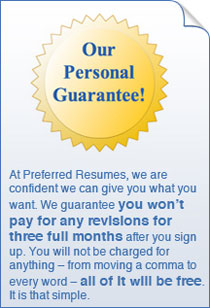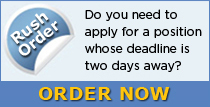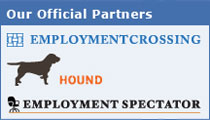Preparing a Scannable Resume
|
|
By using the latest in document imaging technology, your resume can be scanned into a computer system and kept "active" for years. The computer can search for just about anything in your resume. You could be qualified and considered for obs you never thought of or knew about. The computer can make it easier for you to be considered for more jobs, and it keeps your resume on file so it's easier to update your information.
Here's how it works. Your resume is scanned into the computer as an image. Then OCR (optical character recognition) software looks at the image to distinguish every letter and number (character) and creates a text file (ASCII). Then a program "reads" the text and extracts important information about you such as your name, address, phone number, work history, years of experience, education and skills.
Why is it important for you to know this? When you prepare a resume for the computer to read, you want it to be "scannable." A scannable resume is clean so the scanner can get a clean image. A scannable resume uses standard fonts and crisp, dark type such as a laser printer or typewriter with a new ribbon would produce - so the OCR can recognize every letter. And a scannable resume has plenty of facts for the program to extract-the more skills and facts you provide, the more opportunities you'll have for your skills to match available positions.
Preparing a scannable resume is simple. Like the traditional style resume, you focus on format and content.
FORMAT
To maximize the computer's ability to read your resume, provide the cleanest possible original and use a standard style resume.
The computer can extract skills from many styles of resumes such as chronological, functional, key word (organized by skills rather than job titles), and combinations of resume types.
The most difficult resume for the computer to read is a poor quality copy, which has an unusual format such as a newsletter layout, adjusted spacing, large font sizes, graphics or lines, type that is too light, or paper that is too dark.
TIPS FOR MAXIMIZING SCANNABILITY
Use the following guidelines to maximize the computer's ability to "read" your resume:
- Use white or light-colored 8 A x 11 paper, printed on one side only.
- Provide a laser printer original if possible. A typewritten original or a high quality photocopy is okay.
- Avoid dot matrix printouts and low quality copies.
- Do not fold or staple.
- Use standard typefaces such as Helvetica, Futura, Optima, Univers, Times, Palatino, New Century Schoolbook, and Courier.
- Use a font size of 10 to 14 points. (Avoid Times 10 point.)
- Don't condense spacing between letters.
- Use boldface and/or all capital letters for section headings as long as the letters don't touch each other.
- Avoid fancy treatments such as italics, underline, shadows, and reverses (white letters on black background).
- Avoid vertical and horizontal lines, graphics, and boxes.
- Avoid a two-column format or resumes that look like newspapers or newsletters.
- Place your name at the top of the page on its own line. (Your name can also be the first text on pages two and three.)
- Use a standard address format below your name.
- List each phone number on its own line.
The computer extracts information from your resume. You can use your current resume. However, once you understand what the computer searches for, you may decide to add a few key words to increase your opportunities for matching requirements or getting "hits."
Recruiters and managers access the resume database in many ways, searching for your resume specifically or searching for applicants with specific experience. When searching for specific experience, they'll search for key words, usually nouns such as writer, B.A., marketing collateral, Society of Technical Communication, Spanish (language fluency), San Diego, etc.
So make sure you describe your experience with concrete words rather than vague descriptions. The computer system will extract the words and information from your sentences; you can write your resume as usual.
TIPS FOR MAXIMIZING "HITS"
Use the following guidelines to maximize your ability to get "hits" (a hit is when one of your skills matches the computer search):
- Use enough key words to define your skills, experience, education, professional affiliations, etc.
- Describe your experience with concrete words rather than vague descriptions. For example, it's better to use "managed a team of software engineers" than "responsible for managing, training..."
- Be concise and truthful.
- Use more than one page if necessary. The computer can easily handle multiple-page resumes, and it uses all of the information it extracts from your resume to determine if your skills match available positions. It allows you to use jargon and acronyms specific to your industry (spell out the acronyms for human readers).
- Increase your list of key words by including specifics, for example, list the names of software you use such as Microsoft Word and Lotus 1-2-3.
- Use common headings such as: Objective, Experience, Employment, Work History, Positions Held, Appointments, Skills, Summary, Summary of Qualifications, Accomplishments, Strengths, Education, Affiliations, Professional Affiliations, Publications, Papers, Licenses, Certifications, Examinations, Honors, Personal, Additional, Miscellaneous, References, etc.
- If you have extra space, you may wish to describe your personal traits and attitude. Key words could include skill in time management, dependable, high energy, leadership, sense of responsibility, good memory.




